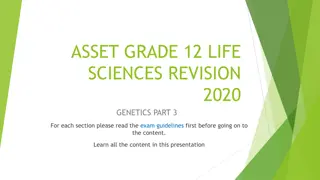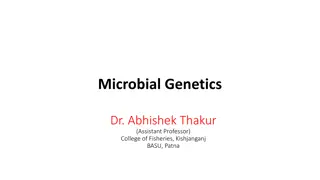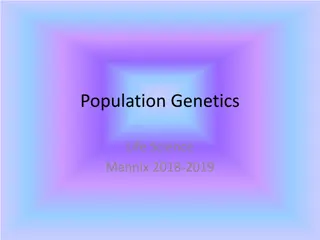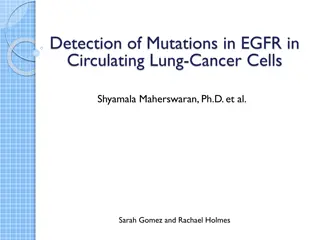Understanding Genetics and Mutations
DNA, the building block of life, contains the genetic code of organisms and is made up of nucleotides. Adenine pairs with thymine and cytosine pairs with guanine in a double helix structure, held together by hydrogen bonds. DNA replication creates identical DNA copies, while transcription produces RNA to carry protein-coding information. Explore the fascinating world of genetics and mutations through this detailed explanation.
Download Presentation

Please find below an Image/Link to download the presentation.
The content on the website is provided AS IS for your information and personal use only. It may not be sold, licensed, or shared on other websites without obtaining consent from the author. Download presentation by click this link. If you encounter any issues during the download, it is possible that the publisher has removed the file from their server.
E N D
Presentation Transcript
Genetics and Mutations By: Nyomi Troy
DNA (deoxyribonucleic acid) DNA is the molecule that contains the genetic code of organisms. It s made of repeating molecules called nucleotides.
DNA Dna has specific pairing between the nitrogen bases. Adenine(A)- Thymine (T) Cytosine(C)-Guanine(G) The backbone is made of Deoxyribose (sugars) connected together by phosphate groups.
Complementary Rule DNA base pairs are always adenine with thymine (A-T) and cytosine with guanine (C-G). Bonding between the nitrogenous bases allow for this structure to form DNA. Each base can only bond with the ones they match with. Adenine(A)- Thymine (T) Cytosine(C)-Guanine(G)
Shape of DNA DNA is shaped like a ladder that s twisted into a coiled configuration called a double helix. The nitrogen bases form the rungs of the ladder and are arranged in pairs, which are connected to each other by chemical bonds.
Bonds that hold DNA together Hydrogen bonds occur between two strands and involve a base from one strand with a base from the second in complementary pairing. Hydrogen bonds aren t that strong and they can easily be disrupted.
Dna Replication It is the process of creating two identical replicas of DNA from one original molecule. Why is it necessary? To ensure that both new contain the correct DNA When does it occur? During interphase, which is the preparation process before cell division How does it work? Enzymes unzip the double helix structure of the DNA molecule, then the complementary nucleotides join each original strand to create a complementary strand. Example Original Strand: AGCTAGAGCAGT Complementary Strand: TCGATCTCGTCA
DNA Transcription The process in which a gene s DNA sequence is copied to make an RNA molecule. Why is it necessary? Transcription makes RNA to carry the code for proteins out of the nucleus to the ribosomes in the cytoplasm. Example DNA: TCGATCTCGTCA Translation RNA: AGCUAGAGCAGU
DNA Translation Ribosomes in the cytoplasm of the cell or the ER create proteins by using info from the RNA. Why is it necessary? Translation ensures that the correct amino acids are paired together by peptides to form the correct protein.
Codon Chart RNA: AGCUAGAGCAGU AGC-UAG-AGC-AGU Serine- STOP RNA: AUGCCGCAAUCU AUG-CCG-CAA- UCU MET-PRO-GIN-SER
Crossing Over The exchange of genes between 2 chromosomes, resulting in non-identical chromatids that comprise the genetic material of gametes. It occurs between prophase 1 and metaphase 1. This happens to allow genetic diversity among living things.
Nondisjunction Failure of homologous chromosomes or sister chromatids to separate subsequent to metaphase in meiosis. Chromosomes are normally separated and distributed evenly to produce four haploid gametes, however sometimes chromosomes don t separate properly. This results in gametes with either too many or too few chromosomes. In humans nondisjunction is more of a risk for those who have children at an older age.
Patau Syndrome It is caused from genetic material on chromosome 13. The extra genetic material disrupts normal development, causing multiple complex organ defects. Some of the effects include intellectual disabilities, motor disorders, skeletal defects and a plethora of many more defects. Two ways it occurs is if each cell contains a full extra copy of chromosome 13 or each cell contains an extra partial copy of chromosome 13. This is an example of nondisjunction because separation resulted in gametes having too many chromosomes, resulting in abnormal gametes.
Mendelian Diseases Autosomal Dominant Disorder: A pattern of inheritance in which an affected individual has one copy of a mutant gene and one normal gene on a pair of autosomal chromosomes. Autosomal Recessive Disorder: The individual has two copies of the mutant gene. X-Linked Disorder: The gene causing the trait is located on the X chromosome and they occur mostly in males.
Achondroplasia (autosomal dominant) Disorder of bone growth that prevents the changing of cartilage characterized by dwarfism, large head, limited range of motion at elbows, small fingers, and much more. The skeletal dysplasia is inherited as a Mendelian autosomal dominant trait with complete penetrance. Those affected with it have inherited an altered FGFR3 gene from 1 or 2 affected parents. This gene provides instructions for making growth factor proteins.
Blooms Syndrome (autosomal recessive) Disorder characterized by short stature, increased sensitivity to ultraviolet rays from sun, multiple small dilated blood vessels over the nose and cheeks resembling a butterfly shape, mild immune deficiency with increased susceptibility to infections and many types of cancer. It s inherited as a Mendelian autosomal recessive trait, connected to chromosomal locus 15q26. 1 (band 26.1 on the short arm of chromosome 15) and is responsible for encoding a protein known as BLM (bloom syndrome protein). A single mutation known as BLMAsh is responsible for almost all cases of Bloom Syndrome.
Ocular Albinism (x-linked) Genetic condition that primarily affects the eyes. This condition reduces the pigmentation of the iris and retina. Pigmentation is primary for normal vision characterized by: severely impaired vision, rapid involuntary eye movements, eyes looking in different directions , sensitivity to light and much more. It s inherited as an X-linked recessive genetic condition caused by mutations in the G protein- coupled receptor 143(GPR143) gene. Gene for pigmentation of eyes and skin.























